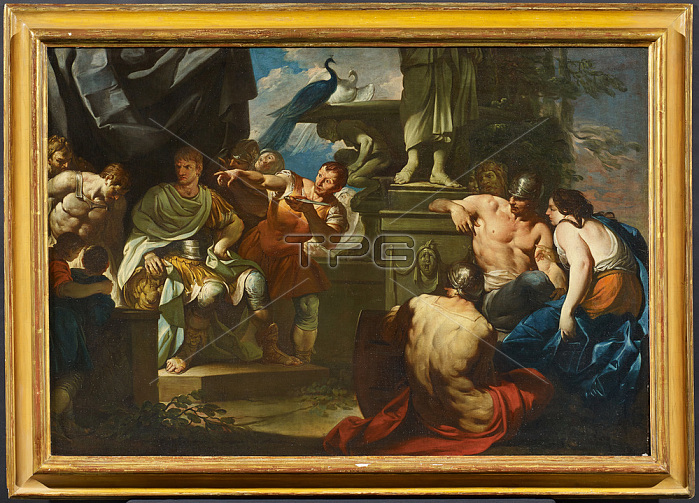
FERRETTI; GIOVANNI DOMENICO
Florence 1692 - 1768
The Condemnation of Philotas by Alexander the Great.
Ca. 1740.
Oil on canvas.
Relined.
97;5 x 143;5cm.
Frame/Pedestal: Framed.
Exhibitions:
"Il fasto e la ragione. Arte del Settecento a Firenze" Exhib. Uffizien Florenz; Florence 2009; cat. no. 57.
Provenance:
Private ownership; Italy.
The present painting is considered one of the most recent additions to the oeuvre of Giovanni Domenico Ferretti; the most important painter of the 18th century in Tuscany. The painting was shown in 2009 on the occasion of the exhibition "ll Fasto e la ragione. Arte del Settecento a Firenze" at the Uffizi Gallery. This extraordinary painting of musequality is part of a pair of paintings with scenes from the life of the King of Macedonia Alexander the Great; which Feretti created around 1740. The counterpart is in the Mus閑 Calvet in Avignon and shows "Alexander the Great and his doctor Philip" (oil on canvas; 100 x 130 cm; Inv. 22811).
This painting shows the conspiracy of the commander Philotas; who finally fell out of favour with Alexander the Great and was executed. The event is mentioned by the Roman historian Quintus Curzius Rufus in the historiographical work "Tales of Alexander the Great": Philotas was accused by his brother-in-law Cenus in front of Alexander the Great; because he feared that he would be regarded as his accomplice and executed. Philotas was then imprisoned and put on trial and then - in the hope of naming the other conspirators - tortured. He was executed that same year; and a short time later his father was also killed by Alexander's entourage; although he had not taken part in the conspiracy.
Like its counterpart in the Museof Avignon; this painting has a vivid chiaroscuro and a colour palette rich in nuances. In his painting; the artist reveals the effects of the Bolognese masters and the inspiration of Venetian painting; which he learned during the years of his training: With the sensuality and elegance of the forms as well as the speed of the ductus; the artist develops a very individual style which becomes his trademark.
The works with scenes from the life of Alexander the Great take up a theme that the artist had previously worked on in the frescoes of Palazzo Nencini in Prato. Ferretti therefore used a successful composition for a diptych intended for an important client who was still unknown. In the 1740s; when the cycle could be traced back to a strict stylistic affinity with other works by the artist; Ferretti's success reached its peak; and the painter's works; with both profane and religious scenes; were highly sought after and in great demand on the art market: in the mid-18th century he painted large paintings and fresco cycles for important Tuscan monasteries and decorations in palaces in Florence and other cities; such as Palazzo Quaratesi and Ceuli in Pisa.
| px | px | dpi | = | cm | x | cm | = | MB |
Details
Creative#:
TOP28562238
Source:
達志影像
Authorization Type:
RM
Release Information:
須由TPG 完整授權
Model Release:
No
Property Release:
No
Right to Privacy:
No
Same folder images:

 Loading
Loading